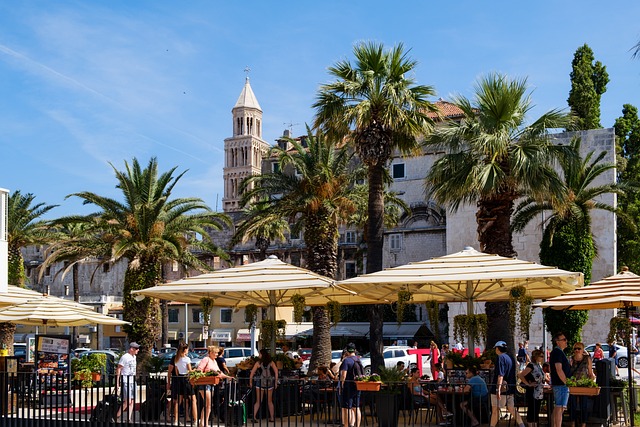When you sit down at Bistro 1968, you’re not just ordering a meal—you’re engaging with art. Each dish is meticulously arranged with an eye for balance and harmony. Think of it as a canvas where colors and textures come together to tell a story. The way ingredients are positioned—sauces drizzled artistically, vegetables stacked with precision, proteins presented with flair—each element plays its part in a culinary symphony.
Ever wondered why presentation matters so much? Just like a well-designed outfit or a carefully curated room, a beautifully plated dish instantly excites your senses. It sets the stage for the flavors to come, making you eager to dive in. At Bistro 1968, every plate is designed to intrigue and impress, transforming dining from a routine into an adventure.
Picture this: a delicate fillet of fish adorned with a vibrant sauce, surrounded by a garden of microgreens and edible flowers. The visual appeal enhances the anticipation, and you find yourself savoring each bite more fully. This isn’t just about aesthetics; it’s about enhancing the overall dining experience.
Bistro 1968’s commitment to presentation reflects its dedication to providing more than just a meal. It’s about creating memorable moments where food becomes a celebration, a feast for the eyes as much as for the taste buds.
Elevating Dining: The Art and Science Behind Bistro 1968’s Menu Presentation
At Bistro 1968, menu presentation is more than just placing dishes on a plate; it’s a thoughtfully crafted experience designed to tantalize your senses. The chefs here understand that presentation is a crucial part of the meal, almost like setting the stage for a performance. Picture this: each dish arrives like a work of art, carefully arranged to highlight colors, textures, and shapes. The plating is deliberate, aiming to enhance the flavors and make every bite an adventure.
But it’s not just about looking good. There’s a science behind it. The team at Bistro 1968 considers factors like color contrast and portion size, ensuring that each plate not only looks appealing but also provides a balanced sensory experience. It’s like designing a perfect puzzle where each piece complements the others, creating a delightful harmony.
Even the choice of plates and utensils is part of this science. By selecting the right dishware, they elevate the meal from ordinary to extraordinary. Think of it as a stage set where every detail is planned to spotlight the main act—your meal.
Dining at Bistro 1968 isn’t just about eating; it’s about experiencing the art and science that goes into every dish. It transforms each meal into an unforgettable event, where every visual and taste element has been meticulously designed to captivate and delight.
Visual Feast: How Bistro 1968 Transforms Plate Design into Culinary Art
When you step into Bistro 1968, you’re not just presented with food; you’re greeted by an experience. Each plate is carefully designed to be as aesthetically pleasing as it is delicious. Think of it as a gallery where the chef is the artist, and the ingredients are their palette. Fresh vegetables, succulent meats, and delicate sauces come together in a harmonious dance of colors and textures.
The real magic happens in the details. The plating at Bistro 1968 isn’t just about arranging food; it’s about storytelling. Imagine a vibrant beetroot puree spread like a rich tapestry, with a perfectly seared steak artistically draped on top, all garnished with a sprinkle of herbs that add a touch of elegance. Each dish is crafted to draw you in, making you eager to snap a photo before you dig in.
Even the utensils at Bistro 1968 play a role in this visual feast. They complement the plates, enhancing the overall aesthetic and ensuring that every aspect of the dining experience feels intentional. It’s as if each meal is designed not just to satisfy hunger but to evoke emotions, transforming an ordinary meal into a memorable event.
Dining here is like attending a culinary performance where the food itself is the star. At Bistro 1968, every plate is a canvas, every dish is a work of art, and every meal is a celebration of creativity and flavor.
From Plate to Palette: Bistro 1968’s Innovative Menu Presentation Techniques
Imagine your entrée arriving not on a traditional plate but on a sleek, rustic wooden board that adds an element of surprise and sophistication. It’s not just food; it’s a canvas. Each dish is meticulously arranged to showcase colors and textures, making every bite a visual delight before it’s even tasted. The chefs at Bistro 1968 understand that presentation is key—after all, we eat with our eyes first.
What truly sets their menu apart is the use of unexpected elements. Picture a dish served in a delicate glass jar, reminiscent of a gourmet terrarium, or a dessert presented under a cloche, unveiling a cloud of aromatic smoke as it’s lifted. These innovative techniques not only make the food look spectacular but also enhance the sensory experience, making each meal memorable.
The restaurant also plays with interactive elements. Some dishes are presented with an accompanying “building kit,” allowing diners to assemble their meal at the table. This interactive approach not only engages guests but also adds a touch of fun to the dining experience. It’s like being part of a culinary performance where you’re the star chef.
Ultimately, Bistro 1968’s approach to menu presentation transcends mere plating. It’s about creating moments of awe and wonder, making each dining experience a journey of discovery. Every detail, from the choice of serving dishes to the interactive elements, is thoughtfully designed to captivate and delight.
The Aesthetics of Flavor: Inside Bistro 1968’s Artistic Plating Process
At Bistro 1968, plating is an elaborate dance of creativity and precision. The chefs there approach each dish with the meticulousness of an artist creating a masterpiece. Picture this: a vibrant array of vegetables, artistically draped over a delicate sauce, garnished with herbs like tiny bursts of color. It’s as if the chef is painting with ingredients, ensuring that each plate tells its own story and invites diners to embark on a sensory journey.
But why is this process so important? Well, think of it this way: just as a beautifully wrapped gift heightens anticipation, a stunning plate enhances the dining experience. Each element is carefully chosen not only for its taste but also for how it complements the visual appeal. The result? An irresistible invitation to savor each bite.
The plating process at Bistro 1968 also involves a bit of culinary alchemy. Chefs experiment with textures, colors, and shapes, creating dishes that are as pleasing to the eye as they are to the palate. This meticulous attention to detail ensures that every dish is a harmonious blend of art and taste, where even the smallest element has a purpose.
In essence, dining at Bistro 1968 is like experiencing a gallery of flavors, where each dish is a carefully crafted artwork. It’s a celebration of how the aesthetics of flavor can transform a meal into a memorable, multisensory adventure.
Mastering the Plate: Bistro 1968’s Approach to Culinary Presentation
At Bistro 1968, they understand that the plate is their canvas. Each dish is meticulously crafted to look as stunning as it tastes. Picture this: a vibrant salad where colors pop like a painter’s palette, or a main course arranged with such precision that it almost feels like you shouldn’t touch it. They don’t just plate food; they craft stories. Every element on the plate is thoughtfully chosen and perfectly placed, ensuring that your meal isn’t just eaten but admired.

Why do they go to such lengths? It’s simple. Presentation isn’t just about aesthetics; it enhances the dining experience. Just like a beautiful photograph can make you pause and appreciate it, a well-presented dish makes you savor every bite more deeply. It sets the stage for a memorable meal and elevates the overall dining experience.
Consider how a beautifully plated dish can transform a regular meal into a special occasion. Bistro 1968’s approach makes you feel like every meal is an event worth celebrating. It’s about more than just filling your stomach; it’s about feeding your soul and igniting your senses. Their attention to detail ensures that every dish is a feast for both the eyes and the palate.
In a world where dining can sometimes feel routine, Bistro 1968 is a reminder of how powerful presentation can be. They prove that with a bit of creativity and artistry, the simple act of eating can become an extraordinary experience.
Behind the Scenes: The Artful Plating Strategies at Bistro 1968
First off, the color contrast is striking. Just like a painter selects their palette, the chefs at Bistro 1968 choose ingredients that pop against one another. A rich, red beetroot might sit beside a vibrant green pea purée, creating a feast for the eyes. This attention to color not only enhances visual appeal but also makes every bite an exciting exploration of flavors.
Texture plays a crucial role too. The plating isn’t just about looking good; it’s about creating a sensory experience. Crispy textures might be juxtaposed with creamy ones, offering a delightful contrast. Think of it like pairing a crunchy, golden-fried element with a smooth, velvety sauce. Each bite is a combination of textures that dances across your palate.
Then there’s the element of height and balance. Rather than stacking ingredients in a haphazard way, the chefs at Bistro 1968 carefully construct each dish to add dimension. It’s akin to sculpting a miniature work of art. This technique not only makes the dish look sophisticated but also ensures that flavors are harmoniously distributed.
Finally, garnishes are not just decorative; they’re integral to the dish’s overall profile. A sprinkle of fresh herbs or a delicate drizzle of sauce can elevate a dish from simple to spectacular. They add that final touch that makes you pause and appreciate the effort that’s gone into every detail.
This meticulous approach to plating ensures that every meal at Bistro 1968 isn’t just eaten but experienced.
Frequently Asked Questions
How Does Plating Affect the Dining Experience?
Plating impacts the dining experience by influencing the visual appeal and perceived quality of the meal. Attractive plating can enhance enjoyment, make the dish seem more refined, and elevate the overall sensory experience.
How Can I Achieve the Perfect Balance on a Plate?
To achieve a perfect balance on a plate, aim to include a variety of food groups: proteins, grains, vegetables, and healthy fats. Use portion control to ensure each group is represented appropriately, typically with vegetables filling half the plate, proteins and grains covering a quarter each, and healthy fats in moderation.
What Are Key Techniques for Plating Bistro 1968 Dishes?
To effectively plate Bistro 1968 dishes, focus on balance and visual appeal. Use contrasting colors to make ingredients stand out, employ proper portioning to ensure each element is highlighted, and arrange components neatly to enhance presentation. Garnish with care to complement the dish and add a final touch of elegance.
What Are the Common Mistakes in Bistro Plating?
Common mistakes in bistro plating include overcrowding the plate, neglecting proper portion sizes, and failing to balance flavors and textures. Other issues involve poor arrangement of components, which can affect visual appeal and eating experience, and improper use of garnishes, which can overshadow the main elements of the dish.
Which Ingredients Enhance Plate Presentation?
Using vibrant vegetables, edible flowers, sauces, and decorative garnishes can significantly enhance plate presentation. Arrange ingredients in a visually appealing manner, considering color contrast, texture, and proportion to create an attractive and appetizing dish.
